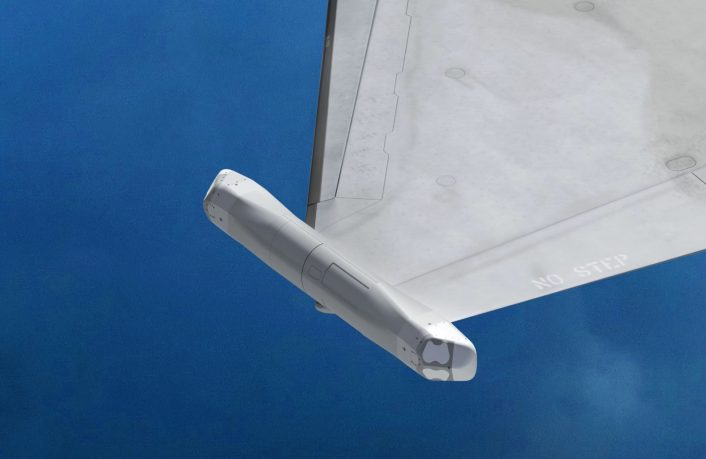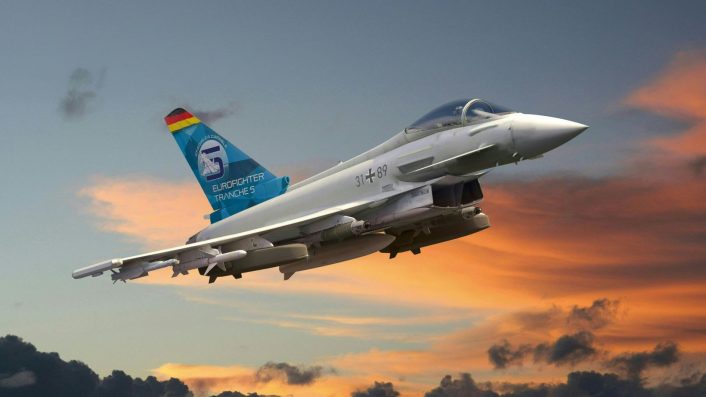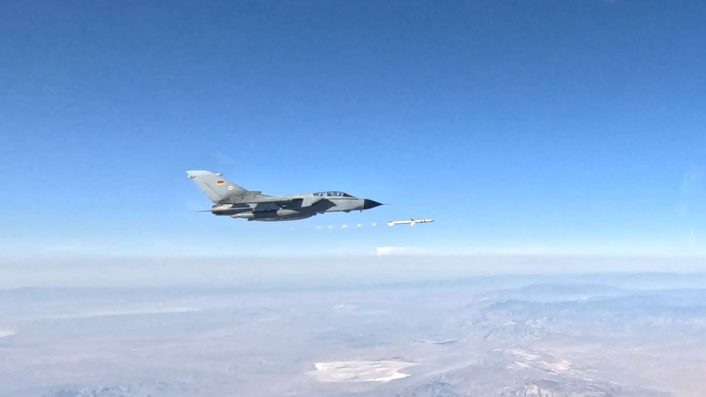The Arexis Electronic Warfare suite will replace the Eurofighter Typhoon’s wingtip pods, part of the fighter’s Defensive Aid Sub-System (DASS).
Germany’s Eurofighter EK program moved forward on Nov. 14, 2025, with a new order for one of its main modifications. In fact, Swedish defense major Saab announced a second order from Airbus regarding its Arexis Electronic Warfare system.
The Eurofighter EK (Elektronischer Kampf) is a dedicated SEAD/DEAD (Suppression/Destruction of Enemy Air Defense) variant of the European jet being developed for the Luftwaffe (German Air Force). Arexis will be the defining feature offering the electromagnetic spectrum, radar-killing and self-protection capabilities.
“The second order includes AI technology by both Saab and its strategic partner Helsing,” Saab explained in the press release. £The order value is approximately EUR 258 million and is subject to authority approval.”
The first EUR 291 million contract signed with Airbus in March 2024 included Arexis’ integration with the Eurofighter EK. The combined total contract value now stands at EUR 549 million.
The delivery period for this latest second order is planned for 2025-2028, while the first order was stipulated to be completed by 2024-26. Saab’s Arexis pods will replace the two existing wingtip pods on the Eurofighter, used to host the Defensive Aid Sub-System (DASS).
Saab receives orders for Arexis system for German Eurofighter.
We are proud to announce that we have received two orders from Airbus Defence and Space for our Arexis electronic warfare sensor suite to equip German Eurofighters.
Read more: https://t.co/bXFGwpeFhg
— Saab (@Saab) November 14, 2025
Rapid progress
Airbus announced the Eurofighter EK, developed as a successor to the older Tornado ECR (Electronic Combat/Reconnaissance), on Nov. 29, 2023. The company has been working with the Bundeswehr’s (German Armed Forces) defense equipment procurement division, the BAAINBw, the Luftwaffe (German Air Force) and the Bundeswehr Aviation Office “on a detailed schedule for the implementation of the selected EK solutions in 15 Eurofighters.”
These first 15 aircraft will not be newly built, but rather aircraft already in service modified to fulfill the new role. It is unclear if work is already underway on these Eurofighters, however a new contract was approved in October 2025 to continue the activities.
“We are proud to deliver Arexis to the German Air Force, which further strengthens the Swedish-German cooperation,” said Saab’s President and CEO Micael Johansson in the latest press release. “Arexis is one of the most advanced fully digital sensors and jamming systems available on the market. The system will improve the Eurofighter’s situational awareness and survivability on the modern battlefield.”

German Eurofighter Tranche 4 and Tranche 5
The Luftwaffe has around 130 Eurofighters (Germany does not officially use the Typhoon name), which include aircraft delivered from Tranche 1 to Tranche 3. The service has signed on for 38 Tranche 4 jets as a part of Project Quadriga to replace an equal number of older Tranche 1s, as well as 20 more as part of Tranche 5.
The Tranche 5 Eurofighters will have the new European Common Radar System (ECRS) Mk 1 AESA (Active Electronically Scanned Array) radar, also known as the E-Scan, as its most important upgrade. This radar, currently in testing, is set to be equipped by German and Spanish Eurofighters.
Tranche 5 aircraft will likely be produced with the Phase 4 Enhancements (P4E) modifications announced in 2024. This configuration includes an automated sensor management capability for all Typhoon radars that will enable the new AESA radar to undertake multiple simultaneous tasks, while reducing the pilot workload.
Other upgrades include an improved cockpit interface and enhanced Radio Frequency Interoperability (RFIO); a Large Area Display that will possibly be included in the new cockpit interface; and a Defensive Aids Sub-System (DASS) for all customers.

German Eurofighter EK SEAD variant
The German Eurofighter EK program, which Airbus initially announced in 2019 as the Eurofighter ECR (Electronic Combat/Reconnaissance), is being developed as a successor to the Tornado ECR. As mentioned above, Airbus will retrofit 15 existing German Eurofighters for this new mission, which will be NATO-certified by 2030.
Moreover, the Tranche 5 aircraft will also be modified to the EK configuration, as the MoD mentioned they would replace the Tornado ECR, possibly from the factory itself.
The German MoD had previously said: “The Eurofighter is to be optimized with the AREXIS self-protection system and corresponding air-to-ground guided missiles and further enabled for electronic warfare.” Arexis is equipped with high-power gallium nitride GaN AESAs and ultra-wideband receivers and Digital Radio Frequency Memories (DRFMs) and is said to be capable of neutralizing Anti Access/Area Denial (A2/AD) systems.
Arexis was originally developed for the Gripen as a podded solution, with Saab having previously said it can be fully integrated on-board an aircraft or fitted externally as a missionized pod, releasing artwork of the Eurofighter EK to show a possible configuration.

Besides Saab’s Arexis, the Eurofighter EK will also use the AGM-88E AARGM, and other technologies developed by small and medium-sized enterprises and start-ups. Notably, these include an AI solution that makes it possible to analyze radar data on-board and quickly determine precise self-protection measures.
Airbus had said on Nov. 29, 2023, that the combination of Saab’s transmitter location system and Northrop Grumman’s AARGM will enable the jet to “detect, localise and disable anti-aircraft radars.” Arexis also “has jammers that improve the Eurofighter’s self-protection,” the company added.
AGM-88E AARGM and Tornado ECRs
The AGM-88E AARGM (Advanced Anti-Radiation Guided Missile) is an advancement over the AGM-88 HARM (High-Speed Anti-Radiation Missile). Its active millimeter-wave radar seeker aids targeting ground-based air defense radars even after they stop emitting.
Anti-air radar crews often intermittently turn on their radars just to be able to quickly check for aerial threats, but not long enough to reveal their position. The new seeker was specifically designed for these situations.

German Tornado ECRs still form the backbone of the Luftwaffe’s SEAD/DEAD missions, having been captured at U.S.-based test facilities like the China Lake Naval Air Weapons Station, California, firing the AARGMs in test flights. As per the World Air Forces 2025 report that counted figures up until December 2024, Germany operates 21 airframes of the Tornado ECR variant, and 63 in the IDS (Interdictor/Strike) version.
Probably the coolest thing I’ve been able to photograph- German Tornados launching missile during their recent live-fire campaign at China Lake 🇩🇪🌪️🚀 pic.twitter.com/fInLbpMObV
— jmh.creates (@JarodMHamilton) April 28, 2025









